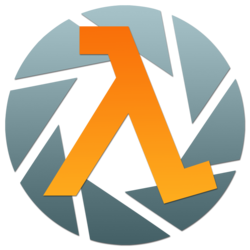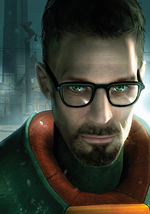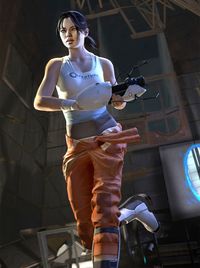《半衰期》与《传送门》宇宙
| 添加一张或多张新图片将为本条目增色不少。 | ||
|---|---|---|
| 警告!本条目尚未按照我们的清扫计划清理到更高的质量标准。它可能仍包含事实错误和无稽之谈,以及拼写、语法或者结构问题,或者是仅仅存在结构问题。在修复完成之前,建议读者谨慎浏览。 | ||
|---|---|---|
您可以通过更正拼写和语法,去除事实错误,并重写一些部分以确保其清晰简洁,以及在适当时候移动某些要素,以帮助清理此页面。 |

| |
| 《半衰期》与《传送门》宇宙 | |
|---|---|
| 开发者 | |
| 发售日期 |
|
| 类型 | |
| 模式 | |
| 平台 | |
| 经销商 | |
| 输入端 |
键鼠、Xbox 360 手柄、DualShock 2\3、Xbox 手柄(EN)、Xbox 360 手柄(EN)、虚拟现实眼镜(VR 眼镜)及其控制器 |
| 引擎 | |
| 系列 | |
| 编剧 | |
| 配乐 | |
《半衰期》与《传送门》宇宙(简称 HL/P 宇宙)是由 Valve 创建的共享科幻世界[1]。该宇宙始于1998年,当时在 PC 平台上发布了首款游戏《半衰期》。
“ Half-Life ”早期在中国大陆的官方译名是《半条命》(奥美电子代理时期)。2019 年《半衰期:爱莉克斯》发布后,新的官网[2]及商店页面均选用《半衰期》作为新的官方译名。
这个宇宙通过四个相互关联的故事线展开,分为《半衰期》和《传送门》两大游戏系列。每个故事线都基于一款核心游戏:《半衰期》、《半衰期 2》、《传送门》和《传送门 2》。《半衰期》系列主打动作与恐怖元素,兼含解谜内容;而《传送门》系列则重点在于解谜和黑色幽默。
自《半衰期》发布以来,衍生出了众多模组、扩展包和续作,它们大多设定在这个宇宙中。其中大部分由 Valve 开发,但《半衰期》的三个扩展包——《蓝移》、《针锋相对》和《衰变》则是由 Gearbox Software 制作。
2005 年 Electronic Arts 开始负责《半衰期》系列的发行工作。
自首部作品问世以来,《半衰期》系列已登陆了许多游戏主机,包括 PlayStation 2、PlayStation 3、Xbox 360,以及 Mac 系统。该系列最初基于金源引擎开发,这是一个经大量修改过的 Quake 引擎(id Tech 2),现在则已经迁移到了起源和起源 2 引擎。
《半衰期》系列的主角是戈登·弗里曼,一名前黑山员工。他在试图逃离黑山基地的过程中,最终成为了 G-Man 的雇员。在系列的扩展包和衍生作品中,玩家可以扮演的角色不再是戈登·弗里曼,而是包括一名 HECU 下士、一名保安和两名女科学家在内的其他角色,他们同样迫切地想要逃离。
在衍生系列《传送门》及其续作《传送门 2》中,主角是雪儿,一名测试对象。她被关押在光圈科技丰富学习中心,该中心由邪恶的失控人工智能 GLaDOS 控制,她也是这一系列的主要反派。
Contents
剧情[edit]
《半衰期》和《传送门》两大游戏系列的故事情节围绕着黑山基地(Black Mesa)和光圈科技(Aperture Science)这两家竞争对手科学研究公司所进行的失败实验及其严重后果展开。黑山基地的实验因分析外来材料引发灾难,而光圈科技的实验则是因为一个人工智能系统变得自我意识并具有攻击性。这些公司的员工、前员工以及外部人员,包括人类和外星人,都深受其灾难性后果的影响。
《半衰期》剧情[edit]
《半衰期》系列的故事始于 200X(EN) 年,在新墨西哥沙漠深处的黑山基地研究设施[3]。戈登·弗里曼,一位最近受雇于黑山的理论物理学家[3],参与了一项分析一种神秘晶体的实验(样本GG-3883)。在前往实验室的途中,他注意到一名神秘的政府人员在电车上注视着他,并且在后续与一名科学家激烈争论。戈登穿上他标志性的 HEV 防护服,前往实验室,途中遇到了几位紧张不安的同事。在巨大的圆柱形实验室内,科学家们向戈登保证一切都会顺利进行,戈登自信地走到控制台前,准备启动实验。在他下方,吉娜·克罗斯将这个非标准晶体送入了输送轨道。
随着电流隧道杆从反物质光谱仪顶部跳到底部,表明机器已准备就绪。待分析的样品被放在推车上,通过升降机送入实验室。戈登将推动晶体进入光束开始了实验。突然间,晶体导致设备严重异常,引发了周围区域的爆炸和破坏。观察区的科学家们拼命试图关闭实验装置,戈登则不知怎么地被传送出了设施,来到了一个陌生的外星世界,并在那里遇到了外星生物。虽然暂时逃脱了灾难,但他对水晶造成的混乱一无所知。
当戈登在实验室内醒来时,四周是一片毁灭与恐怖的景象。反物质光谱仪现在松松垮垮地挂在铰链上,每隔五秒就会爆炸一次,彻底散架躺在地上。三位幸存的科学家之一的伊莱·凡斯帮助戈登继续前进,但在那之前,戈登有机会看到一个奇怪的外星生物凭空出现。似乎在整个设施中,外星人不断出现,无情地攻击科学家们。少数幸存者正试图逃往地面。
深入探索设施的过程中,戈登得知危险环境作战部队(HECU)已被调来控制局势,但他很快发现,他们所谓的“控制”就是消灭黑山基地内的所有人和物。一名保安告诉他,无论如何都必须到达 Lambda 综合体,并在途中发射一颗可以用来关闭次元裂缝的卫星。他利用设施下方的一条废弃铁路系统继续前进。到达终点站后,他发射了 Lambda 团队所需的卫星来封闭裂缝。继续在外表前进时,戈登遇到了黑衣刺客,他们是被派来执行任务的,因为 HECU 屡次未能处理掉弗里曼。戈登被 HECU 抓住,并被扔进了垃圾压缩机。好在戈登及时醒来,设法逃脱并重新找到返回的路。
当戈登抵达 Lambda 综合体时,他被要求传送到边缘世界── Xen 去杀死那个阻止裂缝关闭的生物。出发前,一名科学家给了他长跳模块,可以在 Xen 使用以完成必要的跳跃。Xen 由漂浮的岛屿组成,这里的危险外星生物比黑山基地还要多,戈登迅速赶往尼赫伦斯的巢穴。途中,他卷入了一场与 Gonarch 的战斗,并最终获胜。
尼赫伦斯用威胁迎接戈登的到来,并用强大的黄色射弹对付他。幸运的是,戈登设法击杀了它,裂缝开始关闭。随着尼赫伦斯的遗言在弗里曼脑海中回荡时,G-Man 带走了戈登,并告诉戈登他提供了一份工作,戈登走进了绿色的传送门,接受了这份工作,G-man 将他储存在停滞状态中,从此消失不见。
《半衰期 2》剧情[edit]
约二十年后,G-Man 将弗里曼从停滞状态中唤醒,并将他放置在一个被联合帝国统治的地球上。联合帝国利用黑山事件中产生的次元裂缝征服了地球。在 17 号城市,弗里曼遇到了黑山事件的幸存者,包括艾萨克·克莱纳、巴尼·科尔霍恩、伊莱·凡斯和他的女儿爱莉克斯·凡斯,并协助人类反抗联合帝国的统治。同样被奴役的 Xen 外星生物──弗地岗也加入了反抗军。当弗里曼的存在被前黑山基地管理员、现联合帝国发言人华莱士·布林知晓后,弗里曼成为了联合帝国的目标。最终,弗里曼通过摧毁联合帝国用来制造人形士兵的诺瓦矿场监狱设施,激发了人类的全面革命。随后,伊莱·凡斯及其女儿被联合军抓获,弗里曼帮助反抗军进攻城堡以营救他们。布林企图通过传送逃离,但在弗里曼摧毁城堡顶端的暗能量反应堆时被杀。就在弗里曼即将丧生与爆炸之时,G-Man 出现了,打算再次带离弗里曼,但被弗地岗们打断,他们解救了弗里曼,并将他和爱莉克斯·凡斯传送到城堡底部。当爱莉克斯和阿狗在废墟中找到戈登后,两人试图稳定城堡的主要反应堆,以减缓其爆炸的时间。不久之后,弗里曼和爱丽克斯发现联合军试图摧毁反应堆以召唤来自其母星的增援部队。在下载关键数据后,他们穿过战火纷飞的城市前往火车站,疏散剩余的市民后搭乘最后一班离开城市的列车。然而,联合军摧毁了反应堆,爆炸导致了城堡和 17 号城市的毁灭;这爆炸同时导致了列车脱轨。
弗里曼在一辆残破的火车车厢中苏醒,爱莉克斯站在外面,可以看到原本矗立着城堡的地方现在出现了一个超级传送门。他们开始穿越荒野,前往位于附近山区的反抗军控制下的导弹基地──白森林。途中,弗里曼和爱莉克斯遭到伏击,爱莉克斯被捕食者重创。不过,一群弗地岗治愈了她。爱丽克斯恢复后,两人成功抵达反抗军基地并递交数据,其中包含摧毁超级传送门的代码以及关于北极光号的信息,这是一艘神秘的研究船,由黑山基地的竞争机构光圈科技运营。基地随即发射了一枚火箭,成功关闭了超级传送门,切断了联合军获得外援的途径。然而,就在爱莉克斯和弗里曼准备前往调查北极光号时,他们遭到了联合军探员的袭击,他们在被阿狗赶走之前杀死了伊莱·凡斯。[4]
然而,随着《半衰期:艾利克斯》的故事行进,G-Man 允许爱莉克斯干预这些先前的事件,杀死探员,使伊莱免于死亡,但代价是她的自由,她随后被 G-Man 和及其雇主“雇佣”并置于停滞状态。伊莱和戈登随后出发,对 G-Man 的行为进行报复。
《传送门》剧情[edit]
|
|
在联合军入侵之后[1],一位名为雪儿的测试对象被 AI GLaDOS 从光圈科技丰富学习中心位于上密歇根州的一个休眠仓中唤醒,并使用光圈科技手持传送装置完成了测试。测试包括使用光圈科技配重储存方块、光圈科技高能粒子以及一种特殊版本的储存方块——配重伙伴方块,雪儿被迫将其“安乐死”于焚化炉中。然而,在完成最后一个测试后,雪儿得到的不是所承诺的蛋糕,而是一个焚化炉。她勉强逃过了焚化炉,并开始通过光圈实验室废弃的维修区域寻找逃生路线。结果,她进入了 GLaDOS 的房间。雪儿在 GLaDOS 试图使用神经毒素杀死她的时候,一个个摧毁了 GLaDOS 的人格核心。最终,雪儿成功部分摧毁了 GLaDOS;她的残骸四散,连同雪儿一起落到了光圈科技停车场。不久之后,一个派对护送机器人(Party Escort Bot)将雪儿带回了休息室,几个其他人格核心也被唤醒。
《传送门 2》剧情[edit]
一段时间后,丰富学习中心已经严重损坏,而焦躁不安的人格核心在天花板上的轨道上四处游荡。其中一个核心,惠特利,唤醒了处于休眠的雪儿,并最终说服她将自己从轨道上拆下来。他们无意中唤醒了 GLaDOS,GLaDOS 她将雪儿视为她的“凶手”,并似乎杀死了恵特利。GLaDOS 强迫雪儿通过越来越困难的测试,同时重建光圈设施。一段时间后恵特利再次出现,并帮助雪儿逃离测试。两人一起逃到了设施的制造区,替换了 GLaDOS 的炮塔并关闭了神经毒素。他们回到 GLaDOS 处,此时 GLaDOS 核心已经损坏。他们启动了“核心转移”程序,用恵特利的核心替换了 GLaDOS 的核心。恵特利被权力所腐蚀,将 GLaDOS 的意识转移到了一个土豆中,并把 GLaDOS 和雪儿丢进了设施的深处。
雪儿和 GLaDOS 降落到了位于设施下方的盐矿中的光圈实验室旧址。一只鸟被土豆状态的 GLaDOS 吸引并将她带走。雪儿找到了设施在 50 年代的入口并激活了 斥力凝胶泵,在光圈科学创始人兼前 CEO 凯夫-约翰逊(Cave Johnson)所录制的信息指导下完成了一系列测试。加速凝胶
当雪儿来到 70 年代的光圈实验室时,她发现 GLaDOS 正被带走她的那只鸟啄食。雪儿将 GLaDOS 安装在传送枪上,并启动了电梯和加速凝胶泵。她们一起解决了更多的测试,而 GLaDOS 对约翰逊和他的助手卡罗琳(Caroline)感到困惑,因为她觉得他们的声音似乎很耳熟。
她们到达了 80 年代的光圈实验室,在那里,从约翰逊所留下的信息中得知,他因接触月球上的有毒物质而奄奄一息。他希望自己的意识能被上传到电脑中,作为他的一项计划的一部分,如果这个计划失败,他希望由他的助手卡罗琳来接管实验室。雪儿激活了最后的凝胶并完成了最终的测试,然后再次回到了现在的设施,在那里他们遇到了恵特利,他创造了“Frankenturrets”——一种将方块和炮塔结合在一起的混合体。恵特利迫使雪儿和 GLaDOS 进行更多的测试,但她们最终在恵特利多次试图杀死她们未果后,到达了他的藏身之处。在一场激烈的战斗中,设施逐渐破损,最终屋顶破裂,露出了月亮。雪儿在月球上打开了一个传送门,导致恵特利被吸进太空,而 GLaDOS 则夺回了自己的身体并救回了雪儿。随后,她将Chell送到了地面。
反复出现的主题[edit]
除了典型的 FPS 元素,例如在走廊中奔跑、按下开关以及让玩家扮演“孤胆英雄”,《半衰期》系列还深入探讨了多个主题。这些主题虽然并非在系列每一部作品中都有出现,但主要包括:
| 自由意志的概念 | 在整个《半衰期》系列中,这一概念被反复强调 |
| 自由与奴役的对立 | 这是《半衰期》系列故事情节的核心驱动力,特别是在《半衰期 2》三部曲中 |
| 人性的丧失 | 在《半衰期 2》三部曲中,这一主题尤为突出 |
| 科学实验的失控 | 这在《半衰期》和《传送门》系列中都是一个重要的主题 |
| 宇宙主义 | 该系列深受 H.P. 洛夫克拉夫特作品的影响,其宇宙主义思想贯穿始终 |
| 奥威尔式的反乌托邦 | 在《半衰期 2》三部曲中,这一主题表现得尤为明显。系列作品受到了乔治·奥威尔,尤其是其小说《1984》的深远影响 |
| 传送技术 |
注:此处的《半衰期 2》三部曲指:《半衰期 2》、《半衰期 2:第一章》和《半衰期 2:第二章》
《半衰期》系列中还有许多其他常见的符号和主题:
| 列车 | 几乎每款《半衰期》游戏都是以列车作为开场,即使那些非列车开场的游戏,也以某种形式包含了列车元素 |
| 通风管道 | 玩家经常需要爬进通风管道来到达常规门无法到达的地方。这些管道通常昏暗且充满了猎头蟹 |
| 神秘的 G-Man | 这位神秘人物似乎总是在游戏中暗中观察,他在远处监视着一切,一旦玩家靠近就消失无踪 |
| 猎头蟹和僵尸 | |
| 拉姆达标志(Lambda、λ) | |
| 有毒废物 | 在《半衰期》及其扩展包中,有毒废物呈现出典型的放射性绿色。而在《半衰期 2》三部曲中,17 号城市的运河和荒地中的有毒废物则是棕色的,量也少得多。有毒废物主要用于限制玩家的行动范围。当玩家靠近时,HEV 服的盖革计数器会根据距离发出不同程度的咔嗒声,并在玩家接触时造成伤害,长时间接触则可能导致死亡。在《半衰期》的开场章节“抵达黑山基地”中,可以听到广播系统提示:“如果您感觉到在工作时曝露于辐射或其他危险物质,请立刻联系您的辐射安全官员”讽刺的是,这段提示是在电车经过一处大型放射性泄漏事故现场时播放的。 |
追溯修订[edit]
自《半条命》发布以来,游戏系列的故事情节经历了几次修改(retcons),以适应后续游戏的发展。这些修改主要是为了保持故事的一致性,而不影响对游戏的主要情节和玩法没有影响。
Games[edit]
The Half-Life series has core titles which carry the storyline. The games made in chronological order, portray either the events of one game or a perspective of a different character. As of July 2011, the main series consists of the original video game and its sequel, as well as three expansion packs and two episodic games. A third episodic game remains in development. In addition, several spin-off titles have been released.
GoldSrc games[edit]
Half-Life is the first title for the series, and was the debut title of the Valve Corporation. First released on November 19, 1998, Half-Life follows Gordon Freeman, a theoretical physicist, after the Black Mesa Research Facility accidentally causes a dimensional rift which allows the facility to be invaded by aliens. Freeman attempts to survive the slaughter and resolve the situation. The game was originally published by Sierra Studios and released for Microsoft Windows, although Gearbox Software would later port the game to PlayStation 2 in 2001. Valve themselves later converted the game to utilize their Source engine. Half-Life received critical acclaim upon release, critics hailing its overall presentation and numerous scripted sequences. The game won over 50 Game of the Year awards and its gameplay has influenced first-person shooters for years to come. Half-Life has since been regarded as one of the greatest games of all time.
Half-Life was followed by an expansion pack, Half-Life: Opposing Force, on November 19, 1999. Unlike Half-Life, Opposing Force was developed by Gearbox Software, although it was still published by Sierra Studios. Opposing Force was first announced as a mission pack for Half-Life in April 1999, and was released for the Windows version of the game. The player no longer assumes the role of Gordon Freeman, but rather sees the later events of the first game from the perspective of a US Marine corporal, Adrian Shephard. Shephard is initially assigned to cover up the events at Black Mesa, but is soon left isolated and has to fight to survive against a new group of alien invaders and Black Operations units. Opposing Force was received favorably by critics, many citing the game as being as influential on setting expansion pack standards as the original game had been in influencing the overall genre. The game won the Console Action Game of the Year of 2000 from the Academy of Interactive Arts & Sciences.[5]
Gearbox later went on to develop Half-Life: Blue Shift, Half-Life’s second expansion pack. Announced in 2000, the game was initially developed as an add-on for a Sega Dreamcast port of Half-Life; however, the port was cancelled and Blue Shift was instead released for Windows on June 12, 2001. Blue Shift puts the player in the position of Barney Calhoun, a security guard working at Black Mesa. The game takes place within the early parts of Half-Life, with Calhoun attempting to escape the facility with a small group of scientists. Blue Shift also includes a High Definition Pack, which upgrades the quality of the models and textures in both Blue Shift and the preceding games in the series. Critics gave Blue Shift a mixed but favorable reception, praising the game's atmosphere and the inclusion of the High Definition Pack, but criticizing the otherwise lack of new content and short length of the story.
The third and final expansion for Half-Life was Half-Life: Decay. The game was again developed by Gearbox and published by Sierra. However, unlike previous titles, Decay is only available with the PlayStation 2 version of Half-Life. Decay is unique within the Half-Life series as the only cooperative game. Decay focuses on two of Freeman's colleagues, Gina Cross and Colette Green, as the two work with other scientists to counter the effects of the dimensional rift and ultimately attempt to close it. Released on November 14, 2001, Decay received a weak but overall positive reception from critics, many reviewers stating that it was fun to play through with a friend, but that the game's more puzzle-orientated gameplay detracted from the overall experience. An unofficial Windows port of the game was released in September 2008.
Source games[edit]
On November 16, 2004, Valve released Half-Life 2, the sequel to the original game. The game had a six year development cycle, which saw several delays and the leak of the game's source code. Half-Life 2 returns the player to the role of Gordon Freeman, now employed by the G-Man. Set twenty years after the original game, Earth has been occupied by the Combine, an alien race that exploited the events of the first game to invade. The G-Man inserts Freeman into City 17 to combat the Combine occupation. Half-Life 2 acquired near-unanimous positive reviews and received critical acclaim, winning over 35 Game of the Year awards for 2004. The game has been critically praised for its advances in computer animation, sound, narration, computer graphics, artificial intelligence, and physics. Half-Life 2 was the first title to use Valve's Steam content delivery system, a system that eventually led to Valve falling out with publisher Sierra Entertainment.
Following Half-Life 2, the series was continued using a trilogy of episodic games. Half-Life 2: Episode One was the first of these, set around City 17 after the events of the original game, in which Freeman and Alyx Vance must attempt to escape the city after a dark energy reactor core they damaged at the end of Half-Life 2 threatens to destroy the city. Developed by Valve, the game was distributed online via Steam and through retail by Electronic Arts. It was released on June 1, 2006, and introduced several new graphical effects including new lighting features and facial animation. Episode One received a generally positive critical reaction, although the game's short length was a point of common criticism.
The second episodic game, Half-Life 2: Episode Two, continues the story from where Episode One ended. It was released on October 10, 2007, bundled with the games Portal and Team Fortress 2 as well as Half-Life 2 and Episode One in the package The Orange Box, which was released for Windows PCs, the Xbox 360, and PlayStation 3 consoles. The game was again developed by Valve, and distributed using both Steam and Electronic Arts. Continuing with Valve's policy of orienting each episode around a particular theme or set of technologies, Episode Two focuses on expansive environments, travel, and less linear play. Episode Two's new technologies and gameplay features were praised by reviewers; however, the short length of the game was again a point of criticism.
Half-Life 2: Episode Three is the third and final installment of the episodic expansions developed by Valve Corporation.[6] The game has, presumably, been in development since some time in 2008, since concept art surfaced in July of that year.[7] However, besides passing comments when pressed in interviews, very little is known about the game. Doug Lombardi said that the game would be revealed before the end of 2008, but nothing came of it.
Portal is a puzzle game set in the Half-Life and Portal universe, developed by Valve Corporation. It was initially released alongside Episode Two in The Orange Box on October 10, 2007. The player controls a female test subject named Chell as she moves through the laboratories of Black Mesa's primary rival, Aperture Science, completing various tests with a device that allows her to create linked portals in physical space. In the later stages of the game, the player battles GLaDOS, a corrupt artificial intelligence computer that monitors her every move. The game is the spiritual successor to Narbacular Drop, with many of the same team members working on the game. Portal has been acclaimed as one of the most original games in 2007 despite being comparatively short in length, receiving praise for its unique gameplay and darkly humorous story. An Xbox Live Arcade expansion was released on October 22, 2008.
Portal 2 is the sequel to Portal developed by Valve Corporation. It was released on April 19, 2011. The storyline continues from the end of Portal. The player again controls Chell in the single-player campaign. It also has a cooperative mode with two players taking the role of two androids named Atlas and P-body. The co-op campaign story begins shortly after the single-player story ends.
Spin-offs[edit]
The success of the Half-Life series has spurred the creation of several spin-off games based on the games' plot.
Codename: Gordon is a two-dimensional Flash sidescroller shooter produced by Nuclearvision Entertainment, and was released over Valve's Steam online delivery system on May 17, 2004, as a promotional game for the, at that time, upcoming Half-Life 2. Presently, the game is unavailable on Steam due to its developer's bankruptcy, causing their official site to go offline. Codename: Gordon was well received by reviewers and the public, and attracted over 600,000 players in the first three weeks after its release. Reviewers praised the game for its gameplay and unique dialog style, but also criticized it for its improper optimization, and lack of opponent variety.
Half-Life 2: Lost Coast is a technology demonstration, developed by Valve to display new high dynamic range rendering and a variety of other features. The level was designed with a variety of appropriate environments to emphasize these effects. Consisting of a single map, Lost Coast was originally to be part of Half-Life 2, but was dropped during development. The game follows Gordon Freeman as he travels up a coastal cliff to destroy a Combine artillery launcher in a monastery, which is firing on a nearby town. Released over Steam on October 27, 2005, the level received a generally positive reception, and there was consensus among reviewers that the new features should be implemented into future games released by Valve.
Development[edit]
The video game development company behind the Half-Life series, Valve Corporation, was founded in 1996 in Kirkland, Washington by former Microsoft employees Mike Harrington and Gabe Newell. They began working on the first game of the series soon after the company's formation, and settled on a concept for a horror-themed 3D action game, using the Quake engine as licensed by id Software. The game was a hit at the 1997 E3 convention, where its animation system and artificial intelligence were demonstrated. The game's success led to its first expansion pack, Half-Life: Opposing Force, which was developed by Gearbox Software, a company based in Plano, Texas, and announced on April 15, 1999. Randy Pitchford, founder of Gearbox, said in an interview that he believed Valve gave them the opportunity to produce a sequel to Half-Life to allow Valve to focus on future titles. The game was demonstrated at the 1999 E3 convention, where new locations, characters, and the story were revealed.
The second Half-Life expansion pack, Half-Life: Blue Shift, was again developed by Gearbox Software and announced by its publisher, Sierra Entertainment, on August 30, 2000. The game's story and development direction were first revealed at the European Computer Trade Show in September 2000.
Film adaptations[edit]
A short film loosely based on Half-Life, titled Half-Life: Uplink (not to be confused with Half-Life's second demo with the same title), was developed by Cruise Control, a British marketing agency. The film was commissioned by the U.K. office of Sierra's parent company Havas Interactive in order to promote the game. Produced by Chris Birch and directed by Jamie Matson, Uplink was shot in 12 hours at a decommissioned USAF base in Bedfordshire, England, and was released on the Cruise Control website on March 15, 1999. However, Sierra withdrew it from circulation, after Cruise Control and Valve had failed to resolve licensing issues with Cruise Control over the film. The critical reception of the film was very poor. The film's plot was that of a journalist called Jaz Meadows (portrayed by Patrick Malone) attempting to infiltrate the Black Mesa Research Facility and discover what happened there, assisted only by a woman (voice actress unknown, although since it was announced that the cast includes only four actors, it is most likely Phillipa Norman) who communicates with him through the headset. She tries to talk Jaz out of his plan, but he does not listen, believing that such a report can make him famous. Infiltrating the facility and recording everything he sees with his handheld camera, Jaz stumbles upon a scientist (portrayed by Keith Hillier), who refuses to leave his hiding place and gets killed by the HECU. Meanwhile, Jaz manages to evade several Xen aliens, but is soon confronted by a HECU trooper (Tony Potter). Before the trooper can shoot Jaz, a female Black Op (Phillipa Norman) kills him. She then approaches Jaz and offers him to "come with her if he wants to live". The film ends with Jaz following the Black Op with the end credits saying: "Team Fortress II coming soon...".
In 2013, at the D.I.C.E. summit, Gabe Newell announced that he would be collaborating with director J.J. Abrams and his company, Bad Robot, in order to produce a Half-Life or Portal film.[8]
See also[edit]
References[edit]
- ↑ 1.0 1.1 “Valve 如何打造《传送门 2》” 出自 Eurogamer.net 原文:"How Valve Opened Up Portal 2"
- ↑ 《半衰期》官方网站
- ↑ 3.0 3.1 《半衰期》 PlayStation 2 版说明书
- ↑ Valve 预告《半衰期 2:第三章》 出自 gamespot.com(2008 年 10 月 14 日) 原文:“Valve teases Half-Life 2: Episode Three”(已存档)
- ↑ Academy of Interactive Arts & Sciences 3rd Annual Awards
- ↑ Thorsen, Tor (2006-05-24). Half-Life 2: Episode One gold, Two dated, Three announced. GameSpot. Retrieved on 2009-07-22.
- ↑ Breckon, Nick (2008-07-10). First Half-Life 2: Episode Three Concept Art Revealed. Shacknews. Retrieved on 2009-07-22.
- ↑ 'Portal' or 'Half-Life' movie on the way: J.J. Abrams and Gabe Newell team up at Zap2it

